第二章ipython jupyter的特性
- 魔术命令
- %timeit 测试执行时间
- %debug
- %pwd 输出当前目录
- %whos 显示空间变量
- %run 运行代码
- %reset 删除所有空间变量和名字
- %pdb 出现异常自动进入调试模式
- 魔术命令
第四章 Numpy基础
- ndarray 多维数组 对象
- dtype 数据类型
- shape 各维度大小
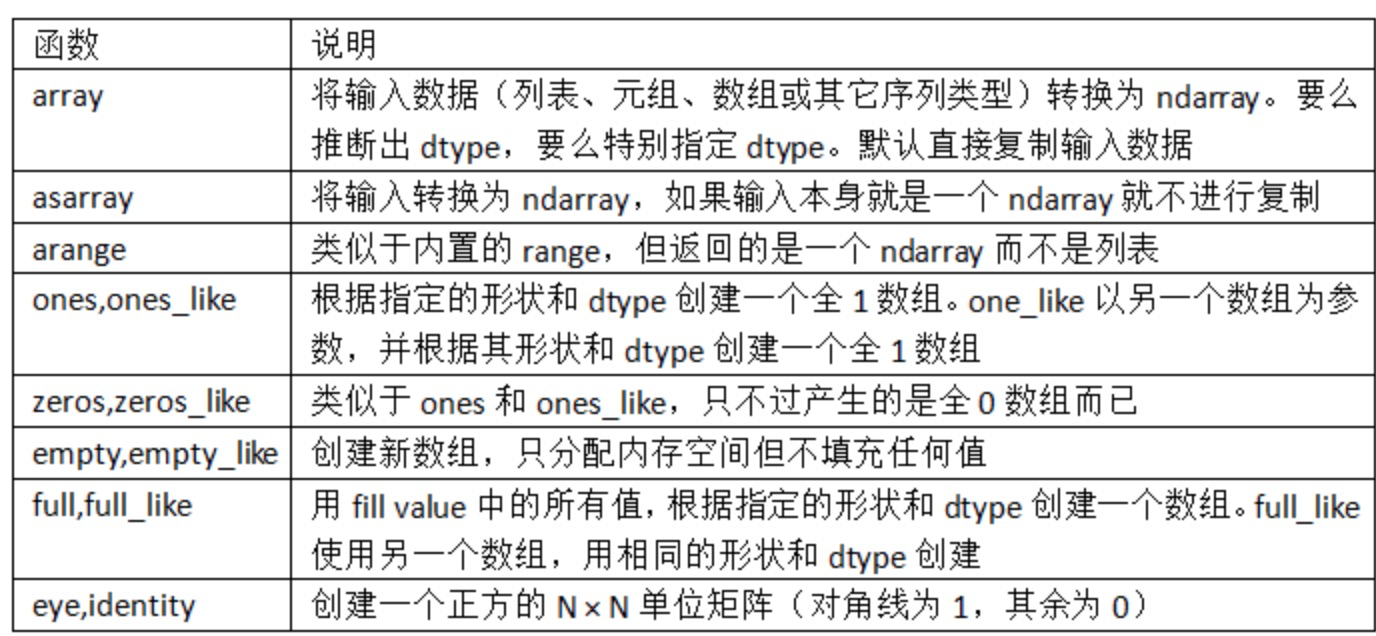
- 切片索引 会直接改变原有结果(按引用传递的概念)
- 花式索引 Fancy indexing
-它指的是利用整数数组进行索引。
-花式索引跟切片不一样,它总是将数据复制到新数组中 - 通用函数
- np.maximum(ndarray1,ndarray2)计算了x和y中元素级别最大的元素。
- np.sqrt(ndarray) 开平方
- np.modf(ndarray) 拆分浮点数
- 数学和统计方法

np.mean(ndarray,axis=0/1) 计算平均值/指定轴 0:x/1:y
np.quantile(0.4) 计算40%的分位数
np.cumsum(ndarray, axis=0/1) 累计和
np.cumprod(ndarray, axis=0/1) 累计积
- 线性代数
- 随机函数
- np.random
- random.randn(line_Num, column_num) : 从标准正态分布中返回一个或多个样本值。
- random.rand() : 随机样本位于[0, 1)中
- random.randint(low=10,high=100, size=(5,5,5)) : 返回555 维鉴于10-100的ndarray
- np.random
- ndarray 多维数组 对象
第五章:pandas入门
- 数据结构
- DataFrame: 表格型数据结构,包含一组有序的列
- 为了更准确选择数据,请使用loc(标签)或iloc(整数)
- 汇总和计算描述统计函数 df.sum(axis=1)求和(axis=0列求和 axis=1行求和)

-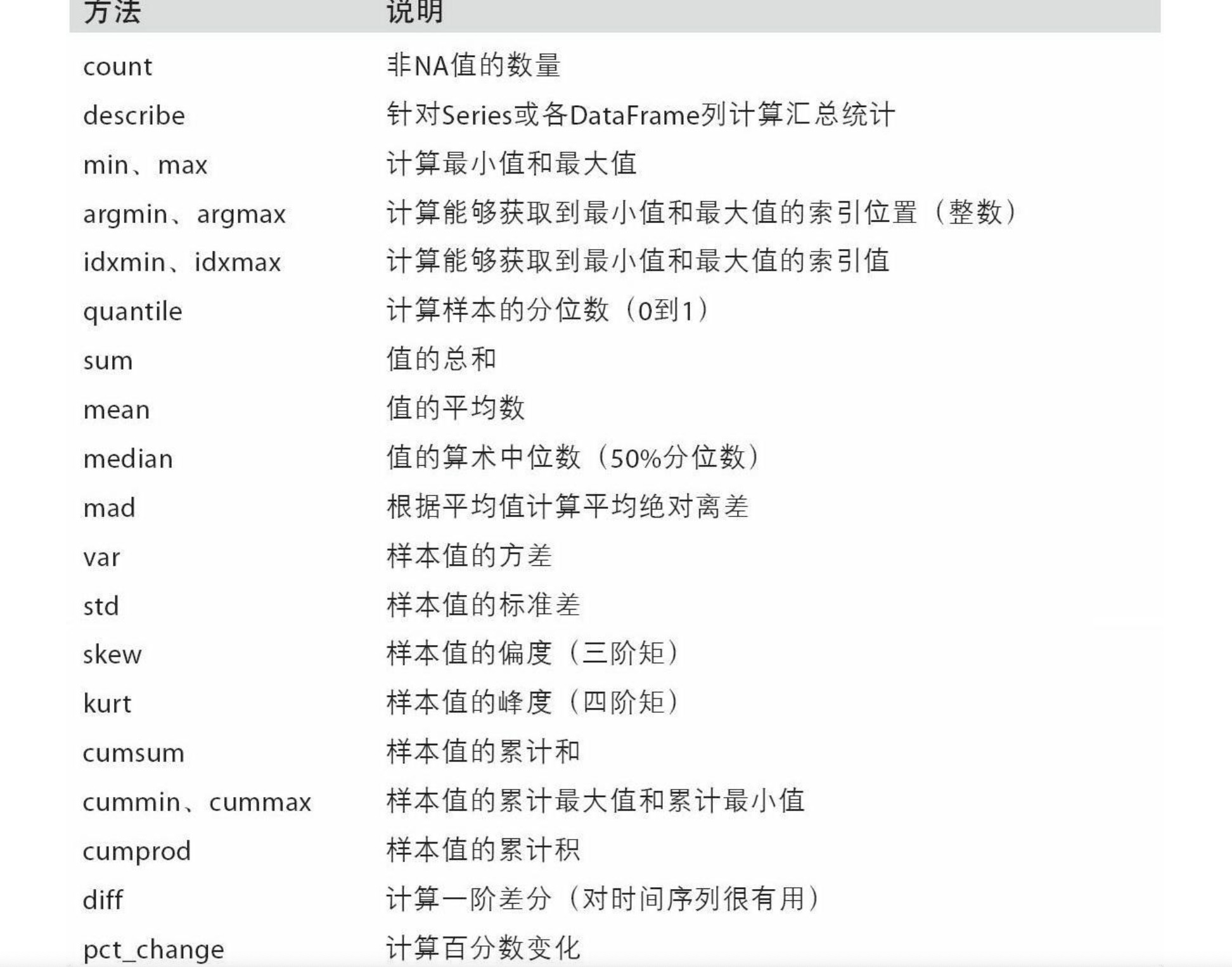
- 求变化率 df.pct_change()
- dataFrame[[column1,column2]] DataFrame
- dataFrame[column1] Series
- DataFrame: 表格型数据结构,包含一组有序的列
- 数据结构
第六章: 数据加载,存储/文件格式
- pandas 加载
- pd函数 pandas - tip
(evernote:///view/498226/s4/7cdcc8cc-4027-4507-9010-3c4fbc0f8f34/7cdcc8cc-4027-4507-9010-3c4fbc0f8f34/) - pd.read_csv(file,na_values={‘message’: [‘foo’, ‘NA’], ‘something’: [‘two’]}) : 默认读取,分割的csv信息为DataFrame格式, message列的foo/NA 都按NaN处理
- pd函数 pandas - tip
- WEB API 调用交互
- pd.DataFrame(requests.get(url).json(),columns=[a1,b2,c3] ) //读取接口返回json中的指定columns字段,生成表格数据结构
- pandas 加载
第七章: 数据清洗和准备
- 填充
- df.fillna(0) , 以0替换na
- df.fillna(method=‘ffill/bfill’,axis=0/1) , 以之前/后(行/列)的非缺失值作为替换Nan的数据
- df.fillna(df.mean()) , 按指定列平均值替换Nan数据
- df.drop_duplicates(['k1],keep=‘last’), 丢弃k1列重复的数据,并保留最后一个
- 替换
- df.replace({-999:np.nan,-1000:0}) 将数据中的-999替换成为nan,-1000替换成为0
- axis indexes rename(轴索引重命名)
- df.rename(index={‘a’:‘a-replace’,‘b’:‘b-replace’},columns={‘ac’:‘ac-replace’} , inplace=True)重命名各轴的标签名, 更改原数据
- df.index.map(lambda x: x[:4].upper()) 改index的表情名, 取字符串前4位,并全部转化为大写
- Discretization and Binning(离散化/面元划分)
- pd.cut(data, 4, precision=2) 小数位2precision data.均分4分
- pd.cut(data, bins) 按照bins间隔换分data
- pd.qcut(data, bins) 自定义的bins
- Detecting and Filtering Outliers(检测过滤异常)
- data[(np.abs(data) > 3).any(1)] 过滤
- np.sign(data) 根据数据的值是正还是负,np.sign(data)可以生成1和-1:\\
- 的
- 哑变量(虚拟变量)? 离散特征量化手段哑变量
- pd.get_dummies(df[‘column’],prefix=‘xxx’), 把df[‘column’]列转换为哑变量矩阵,并且以prefix为前缀
- 填充
第八章: 数据规整:聚合,合并和重塑 @todo
- Hierarchical Indexing(层次化索引)
- f
- Hierarchical Indexing(层次化索引)
第九章:绘图/可视化
- fig = matplotlib.pyplot.figure() //初始化画布
- fig.add_subplot(2,2,1) 构建2*2 图像,并选中第1个.
- ax = fig.plot(x, y, g–) / fig.plot(x, y , linestyle=‘–’, color=‘g’) ,绘制绿色虚线连续线图
- ax.set_xticklabels([‘one’],rotation=30,fontsize=‘larger’) 设置subplot 的x label 倾斜30°, 大字体
- ax .legend(loc=‘best’,title=‘hell’) 设置图标右上角比例提示
- 批量设置属性
1
2
3
4
5
6
7
8props1 = {
'title' : 'My First Matplotlib Plot!', //设置标题
'xlabel': 'Stages', //设置x label
'ylabel': 'rate',
'xlim':[2,8], //设置x起始值,结束值
'ylim':[-1,1]
}
axs[1].set(**props1)- plt.savefig(‘figpath.png’,dpi=400,bbox_inches=‘tight’) 当前目录保存为400像素最小白边的png图片
- dataFrame.plot(kind=‘box’,title=‘box’,alpha=0.7, color=‘k’) // 箱图,透明度0.7, k颜色
- dataFrame.plot(kind=‘bar’,title=‘bar’) //祖壮图
- dataFrame.plot(kind=‘line’,title=‘line’) //线图
python pandas.DataFrame基本函数 查看数据 .head() .tail() .shape .describe() 矩阵运算 .add() .sub() .mul() .div() .divmod() .combine() 矩阵比较 .eq() .ne() .lt() .gt() .le() .ge() 数据框连接 .align() .merge() .join() .concatenate() 设置行名列名 .column .reindex() .reindex_like() 列操作 .drop() .insert() .assign() 数据类型 .dtypes .get_dtype_counts() .astype() .to_numeric()… .select_dtypes() 数据运算 .pipe() .apply() .applymap() 统计运算 .cut() .qcut() .idxmin() .idxmax() .value_counts() .sum()… 排序 .sort_index() .sort_values() .nsmallest() .nlargest() 其他 .dt Iteration .copy() .info() - 直方图(histogram)/密度图(kde)
- f
第十章 数据聚合与分组运算
- split-apply-combine(拆分-应用-合并)
- 随机采样/排列
- 的
- 分组加权平均数和相关系数
- v
- df.pivot_table() Pivot Tables: 透视表 的参数说明请参见表10-2。

- df.Crosstab() Cross-Tabulations:交叉表
1 | pd.crosstab(data.Nationality, data.Handedness, margins=True) === pd.pivot_table(data=data,index=['Nationality'], columns=['Handedness'],aggfunc='count',margins=True, margins_name='综合') |
第十一章 时间序列
日期转换: df.to_period(‘M’) : 转换日期格式为每月 2012-01-01 --> 2012-01
数组生成periodIndex:
1
2>> pd.PeriodIndex(year=data.year, quarter=data.quarter, freq='Q-DEC')
>>freq:
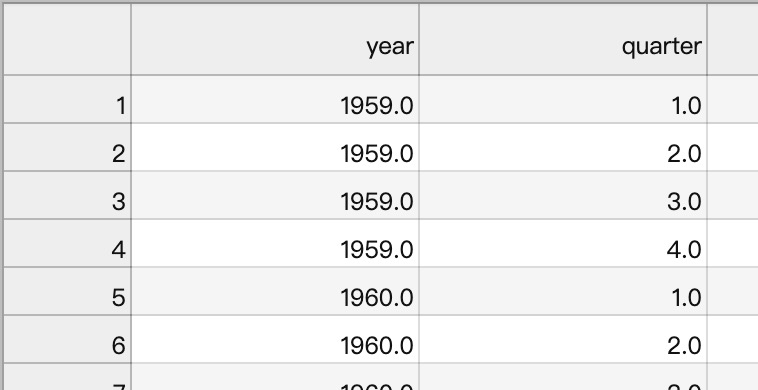
降采样:
resaTs = ts.resample('5min', closed='right', label='right', loffset='-1s').sum():重新按照5min间隔, 右封闭, 右lable -1s 为key名, 样本和1
2
3
4
5
6
7
8
9
10
11
12
13ts:
2000-01-01 00:00:00 0
2000-01-01 00:01:00 1
2000-01-01 00:02:00 2
2000-01-01 00:03:00 3
2000-01-01 00:04:00 4
2000-01-01 00:05:00 5
...
resaTs:
1999-12-31 23:59:59 0
2000-01-01 00:04:59 15
2000-01-01 00:09:59 40
2000-01-01 00:14:59 11OHLC重采样(resampling): 融领域中有一种无所不在的时间序列聚合方式,即计算各面元的四个值:第一个值(open,开盘)、最后一个值(close,收盘)、最大值(high,最高)以及最小值(low,最低)
- df.resample(rule=‘M’, kind=).
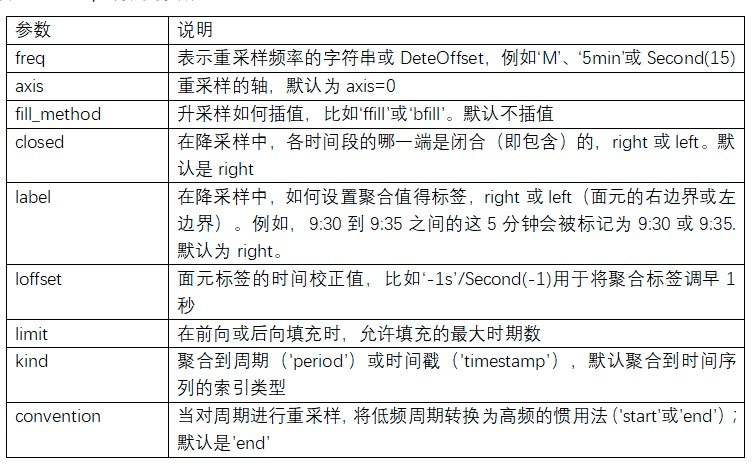
- df.resample(rule=‘M’, kind=).
升采样/插值
df.resample(‘D’).asfreq() : 强制升采样Year Colorado Texas 2000-01-05 0.746433 2.224660 2000-01-12 -0.679400 0.727369 ===>
Year Colorado Texas 2000-01-05 0.746433 2.224660 2000-01-06 Nan Nan … Year Colorado Texas 2000-01-12 -0.679400 0.727369 指数加权函数
- 否
第十二章 pandas高级应用
- seriesData.take(seriesData) : 用整形表示类别的方法 : 分类
1
2
3
4
5
6
7
8
9
10
11
12>> values = d.Series([0, 1, 0, 0] * 2)
>> dim = d.Series(['apple','orange'])
>> dim.take(values)
>>
0 apple
1 orange
0 apple
0 apple
0 apple
1 orange
0 apple
0 apple- SeriseData.astype(‘category’).act.xxxx
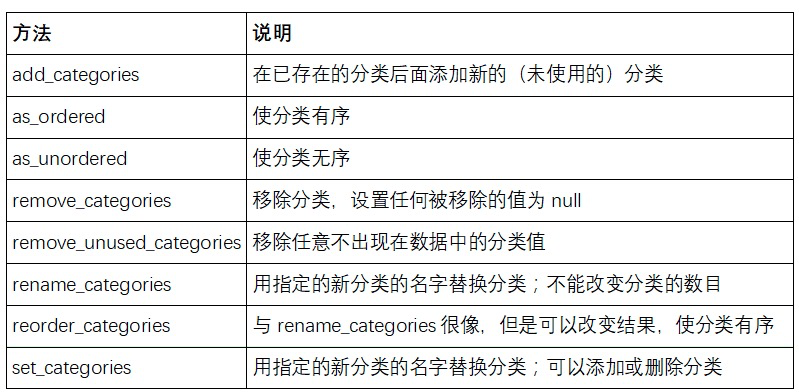
- pd.get_dummies(pd.
- df.groupby(‘key’).value.transform(lambda x: x.mean()) 求取与df同等格式的平均值DataFrame
- 链式编程
1
2
3
4df2 = df.assign(k=v)
==等价于=
df2 == df.copy()
df2['k'] = v1
2
3
4
5
6
7
8
9
10
11
12
13
14
15
16
17
18
19
20
21
22
23
24
25
26
27# =========> 原始
df = load_data()
df2 = df[df['col2'] < 0]
df2['col1_demeaned'] = df2['col1'] - df2['col1'].mean()
result = df2.groupby('key').col1_demeaned.std()
# =========> 转化过程
# Usual non-functional way
df2 = df.copy()
df2['k'] = v
# Functional assign way
df2 = df.assign(k=v)
result = (df2.assign(col1_demeaned=df2.col1 - df2.col2.mean())
.groupby('key')
.col1_demeaned.std())
df = load_data()
df2 = df[df['col2'] < 0]
df = (load_data()
[lambda x: x['col2'] < 0])
#=========> 最终
result = (load_data()
[lambda x: x.col2 < 0]
.assign(col1_demeaned=lambda x: x.col1 - x.col1.mean())
.groupby('key')
.col1_demeaned.std())
第十三章 python 建模库
- np.ndarray 是 pandas与其他分析库的数据中介桥梁
dataFrame.value => np.ndarray
变量的虚化,产生虚拟变量
1
2
3
4
5
6
7
8
9
10
11
12
13
14
15
16
17
18
19
20
21
22
23
24
25
26
27
28
29# 为categroy 变量,创建虚变量,并替换自己
>>> data = pd.DataFrame({
'x0': [1, 2, 3, 4, 5],
'x1': [0.01, -0.01, 0.25, -4.1, 0.],
'y': [-1.5, 0., 3.6, 1.3, -2.]})
>>> data['category'] = pd.Categorical(['a', 'b', 'a', 'a', 'b'],
categories=['a', 'b'])
>>> data =>
x0 x1 y category
0 1 0.01 -1.5 a
1 2 -0.01 0.0 b
2 3 0.25 3.6 a
3 4 -4.10 1.3 a
4 5 0.00 -2.0 b
>>> #说明: type(data.y.values) ==> numpy.ndarray
# type(data.category.values) ==> pandas.core.categorical.Categorical
>>> dummies = pd.get_dummies(data.category, prefix='category')
data.drop('category', axis=1).join(dummies)
>>> result ==>
x0 x1 y category_a category_b
0 1 0.01 -1.5 1 0
1 2 -0.01 0.0 0 1
2 3 0.25 3.6 1 0
3 4 -4.10 1.3 1 0
4 5 0.00 -2.0 0 1- Patsy(库)线性模型描述(创建数据矩阵)
1
2
3
4
5
6
7
8
9
10
11
12
13
14
15
16
17
18
19
20
21
22
23
24
25
26
27
28>>> df = pd.DataFrame({
'x0':[1,2,3],
'x1': [0.1,0.1,0.25],
'y' : [-1.5, 3.6, -2.]
})
>>> y, X = patsy.dmatrices('y ~ x0 + x1', data)
>>> y
DesignMatrix with shape (5, 1)
y
-1.5
0.0
3.6
1.3
-2.0
Terms:
'y' (column 0)
>>> X
DesignMatrix with shape (5, 3)
Intercept x0 x1
1 1 0.01
1 2 -0.01
1 3 0.25
1 4 -4.10
1 5 0.00
Terms:
'Intercept' (column 0)
'x0' (column 1)
'x1' (column 2)- 用Patsy公式进行数据转换
1
2
3
4
5
6
7#使用样本的design规则, 格式化新数据
>>> new_data = pd.DataFrame({
'x0': [6, 7, 8, 9],
'x1': [3.1, -0.5, 0, 2.3],
'y': [1, 2, 3, 4]})
>>> patsy.build_design_matrices([X.design_info], new_data)
>>> y, X = patsy.dmatrices('y ~ I(x0 + x1)', data) # 按照x0+x1的结果构建矩阵 - 分类数据和Patsy
- 非数值数据可以用多种方式转换为模型设计矩
- 用Patsy公式进行数据转换
- statsmodels介绍
- np.ndarray 是 pandas与其他分析库的数据中介桥梁
